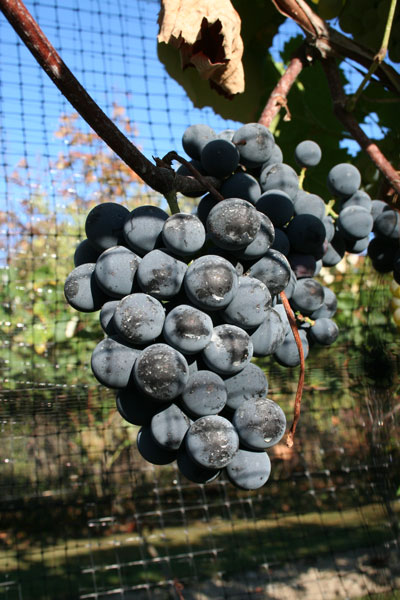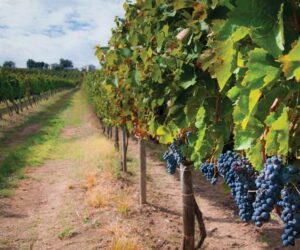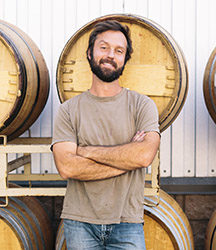
Growing up in a conservative household in the Midwest I was never allowed to listen to rock and roll music at home. We had to sneak over to friends’ houses to hear all the latest and greatest rock-and-roll that was being released. Jimi Hendrix first released “Foxy Lady” in 1967, and as a seven-year old, I had no interest in anything “foxy,” let alone even knowing what the word meant. To keep this definition gender neutral, let’s just say that foxy, in that 1960s tense, means someone who is attractive, and you want to spend more quality time with them. Fast forward many years as I was getting more and more interested in wine, I was at a tasting and someone was describing a wine as foxy. I couldn’t help but think they wanted to spend more quality time with the wine. But the sensory term, if it was so appropriate for the wine, needed to be fleshed out in the wine descriptor world. So I asked what the term implied. The answer given was that it was difficult to describe, but if you really wanted a good example of foxy, go purchase some Concord grape jelly. Turns out, I grew up on that jelly and I knew the descriptor well. Concord is our native variety and as I researched this foxy lady, I find it has a lot more going for it than just jelly.
Concord was the American grape for over 150 years. Grape breeder Ephraim W. Bull of Concord, Massachusetts found a wild grape growing on his property in 1843. The wild grape was a Vitis lubrusca, commonly found growing wild in that region of the country. He moved that plant to his garden area where it was allowed to cross-pollinate with the other grapevines growing there, one of them being Catawba. In breeding terms, this would be known as an interspecific crossing because the rest of the grapes in his garden were thought to be Vitis labrusca. From the fruit come seeds and the resulting seed he chose to plant he later named Concord when it came to fruit in 1849. It was presumably 100% V. labrusca. But some doubts lingered whether it was a V. labrusca x V. vinifera hybrid. The doubts arose from experts who examined the Concord vine and found certain ampelographic characteristics that resemble vinifera.
Notably, underneath the foxiness, is a vinous fruit taste, similar to vinifera. It is susceptible to powdery mildew, where most American varieties are resistant, and has intermittent tendrils. This information comes from material published in 1907 by U.P. Hedrick, who worked for the New York Agriculture Experimental Station in Geneva, New York. Genetic testing did not exist then, so grape breeders were keen on documenting the specific morphology of the vines, hence the science of ampelography. Jancis Robinson reported that it was likely a vinifera hybrid based on work done by Laurenzo Stover in 2009. Today, the Vitis International Catalogue, (http://www.vivc.de) lists the parentage of Catawba as a labrusca x vinifera hybrid. At last, the vinifera parent had been identified. It was Sémillon. Now, after one hundred years, the vinifera connection had been established. Catawba’s breeding history is not well known, but it is said that if Catawba had not come along, growing grapes in the East would have lagged by many years, subsequently, perhaps Concord would have never been a thing.
Concord is widely known in the northern latitudes of North America. The most widely planted areas are divided into two zones; western and eastern. Washington state has roughly 20,000 acres reported in 2016. In the Eastern US, in what is known as the “Lake Erie Concord Belt,” the vines encompass about 30,000 acres in its entirety. The Lake Erie Concord Belt stretches across northern Pennsylvania, and into New York state with about 18,000 acres of that growing in New York. It is reported that up to 150,000 tons of Concord fruit are harvested, supporting 2,000 jobs and contributing about $340,000 to the local economy. Elsewhere in the US: Ohio, Michigan, Illinois, Indiana, Iowa, and Missouri have plantings reported to be used for wine.
This grape variety is winter-hardy, productive, and vigorous. The berries are large on medium-sized bunches. In warmer climates it is subject to uneven ripening. It is classified as late budding and mid- to late-season ripening. In the vineyard it is susceptible to powdery mildew, black rot, phomopsis, and eutypa, but less so to downy mildew and Botrytis. It can grow in a variety of soil types and under more variable climatic conditions than any other variety in North America.
It is susceptible to powdery mildew, where most American varieties are resistant, and has intermittent tendrils.
While we know it most from its inclusion in Welch’s grape jelly and grape juice, in the wine world, Concord is the base variety for the best known of the Manischewitz wines. This sweet kosher wine, abundant with the Concord funky-grapey foxiness character, is more about tradition than it is about the wine. Wine that is described as foxy will have the distinctive note of methyl anthranilate, a chemical also secreted by the musk glands of dogs and foxes. V. labrusca grapes are noted to contain the highest levels of methyl anthranilate of all known grapes. But this characteristic can be minimalized when handled properly. In this piece, we’ll find out best practices with Concord and how it can be a different beast in the winemaking world.
Wine grape versus table grapes, what is the difference? By table grape, we refer to a grape with or without seeds that you pop in your mouth for a snack, or you make into jelly. Table grapes are usually lower in sugar (14–16 °Brix), with a variable acidity range (generally > 8–10 g/L) based on the climate where it is grown. Wine grapes are higher in sugar (21–24 °Brix), and lower in acid (< 8–10 g/L). So where does Concord fall? Concord by these definitions would be a table grape, and to make it into a wine grape, it takes some effort on the winemaker’s part to convert these into a wine grape. The first level of intervention is dealing with the low sugar. Concord needs to have sugar added to it to increase the potential alcohol levels in the resultant wine to balance the acidity. This is a process called chaptalization and how much chaptalization occurs depends on the grape’s average Brix readings.
There are a couple of different ways to chaptalize, from simply adding dry sugar, to preparing a standard solution of known sugar concentration. Adding dry sugar is less predictable due to solubility and mixing issues. These can lead to higher than predicted alcohol levels. In practice I have found that the water component of the standard solution is better to help balance the acid levels in the end. Therefore, I prepare a 25 °Brix standard solution using corn sugar (glucose). Some people will use table sugar (sucrose) which is a disaccharide of glucose and fructose. If you use table sugar your yeast choice will be important, since the fructose component needs to be converted to glucose to be fermented. Thus a “fructophilic” yeast should be used if you plan to chaptalize your must with table sugar. Most yeast have this capability, but some are better at it than others. Check your favorite yeast supplier’s reference charts. Regardless of what sugar type you use, mixing is the key, therefore a non-standard order to the maceration process will help.
While not really non-standard methods, there are some things we want to accomplish when making wine with Concord grapes. Notably, color extraction and the foxiness from methyl anthranilate are both attributed to skin contact. Plan to soak the must prior to fermentation. In this way, you won’t get the deep color you think of in a red wine, but you will reduce the foxiness. To do this, the general scheme would be to destem and crush the fruit, add some pectic enzyme (check the package for recommended dosage, see note in the recipe), and then soak for desired color (2–10 hours, variable depending on what color you are looking for), then press the juice free. Concord is known as a slip-skin variety, which means the insides easily slip out of the skin. This characteristic means you have to have patience in the pressing process. One piece of advice for pressing slip-skin grapes is to add rice hulls to the must when you are ready to press. The rice hulls are a pressing aid and will improve your juice yields, depending on the press type used. After you have the juice of the desired color, you can begin the chaptalization process to establish your starting juice.
For chaptalization, one of my favorite calculators for this purpose is the one put out by Wine Business Monthly (https://www.winebusiness.com/tools). Look under the chaptalization tab and it walks you through the process. The only thing you really have to do is figure out how to prepare your standard solutions. When preparing standard solutions, remember that Brix is defined as weight of sugar in grams, per 100 grams of solution. This is known as a weight/weight (w/w) relationship. So a 25 °Brix solution is 25 grams of dextrose per 100 grams of solution. At 68 °F (20 °C), 1 milliliter of water will weigh 1 gram. Therefore 5 gallons of water, or 19 liters, will weigh 19 kilograms at 68 °F (20 °C).
In the end, it’s the fermentation starting conditions that are important, and I focus solely on adjusting for potential alcohol. Once the fermentation is complete, I begin to look at the other parameters like acidity, residual sugar, and taste; focusing on the overall perceived balance of the wine. If it is too acidic, one can consider de-acidifying through malolactic fermentation, sweetening to counteract the acidity, or using a combination of both. Concord is one foxy table grape that can be transformed into a wine grape that you may want to spend more quality time with.
Concord Recipe
(5 gallons/19 L)
Ingredients
40 lbs. (18 kg) Concord fruit
Pectic Enzyme (like Lallzyme-EX, which contains pectinases and hemicellulases. Use 0.5 g per 40 lbs./18 kg of fruit. This product may be difficult to obtain in such small quantity. Check with your local winemaking shop.)
Chlorine-free water
10% potassium metabisulfite (KMBS) solution (Weigh 10 grams of KMBS, dissolve into about 75 milliliters (mL) of distilled water. When completely dissolved, make up to 100 mL total with distilled water.)
Lallemand EC-1118 yeast
5 grams Fermaid K (or equivalent yeast nutrient)
5 grams Di-ammonium phosphate (DAP)
Dextrose (corn sugar)
Other equipment or needs
5-gallon (19-L) carboy
6-gallon (23-L) carboy
30-gallon (114-L) plastic bucket (should be food-grade plastic)
1-gallon (4-L) plastic jug
Airlock/stopper
Racking hoses
Equipment cleaning and sanitizing agents (Bio-Clean, Bio-San)
Inert gas (nitrogen, argon, or carbon dioxide will do)
Refrigerator that holds a carboy and maintains standard refrigerator temperatures
Ability to maintain a fermentation temperature of 75 °F (24 °C)
Thermometer capable of measuring between 40–110 °F (4–43 °C)
Pipettes with the ability to add in increments of 1 milliliter
Clinitest® tablets to measure residual sugar at the completion of fermentation
Ability to test or have testing performed for sulfur dioxide
Step by Step
- Prepare a 25 °Brix solution. Weigh 30 lbs. (13.3 kg) of chlorine-free water, and add to it 7.3 lbs. (3.3 kg) of dextrose. Mix until completely dissolved and measure Brix. Adjust with more sugar or water if necessary.
- Crush and de-stem the grapes. Move the must directly to your 30-gallon (114-L) plastic can and add your pectic enzyme. Mix well and keep in a cool place.
- Monitor for color extraction and flavor over the next several hours. When you are happy with the results, move the must directly to the press and press lightly to avoid aggressive contact with the skins and seeds. This recipe assumes a yield of approximately 2 gallons (7.6 L) of juice for 40 lbs. (18 kg) total weight of fruit. Don’t overpress to get this volume though.
- Transfer the juice to a 6-gallon (23-L) bucket. During the transfer, add 8 milliliters of 10% KMBS solution (This addition is the equivalent of 20 mg/L (ppm) SO2). Move the juice to the refrigerator. If you have yielded more juice during pressing, place into the one-gallon (1-L) plastic jug and settle as with the main lot of juice. Let the juice settle at least overnight. Layer the headspace with inert gas and keep covered.
- When sufficiently settled, rack the juice in the bucket off of the solids into the 6-gallon (23-L) carboy (keep jug separate). Measure the Brix. Use a chaptalization calculator (such as at www.winebusiness.com/tools) to adjust the juice with your sugar solution to about 22 °Brix. Rack off the solids in the jug, then return to the jug and freeze for step 12.
- Prepare yeast (EC-1118) per manufacturer’s instructions.
- Add Fermaid K/yeast nutrient.
- Initiate the fermentation at room temperature ~(66 °F/19 °C) and once fermentation is noticed, (~24 hours) move to a location where the temperature will be 75 °F (24 °C).
- Two days after fermentation starts, dissolve the DAP in as little distilled water required to completely go into solution (usually ~ 20 mL). Add directly to the carboy.
- Wait until the bubbles in the airlock are about one bubble per minute, then measure the Brix every 2–3 days.
- The wine is considered dry, or nearly dry when the Brix reaches -1.5 °Brix or less.
- Taste the wine. If it is too tart, consider the following: Inoculating for the malolactic fermentation using Chr. Hansen freeze-dried cultures AND/OR thaw some of the previously frozen juice (step 5) to sweeten the wine and balance the finish. You could use grocery store bought grape juice concentrate or grape juice if no extra juice was obtained.
- When the desired taste is obtained, add 3 mL of fresh KMBS (10%) solution per gallon (0.8 mL per L) of wine. This is the equivalent to ~40 ppm addition. Transfer the wine to the five-gallon (19-L) carboy and lower the temperature to 38–40 °F (3–4 °C).
- After two weeks, test for pH and SO2 adjust to attain 0.8 ppm molecular SO2. (There is a simple SO2 calculator at www.winemakermag.com/guide/sulfite). Check the SO2 in another two weeks, prior to the next racking and adjust while racking. HINT: Rack to another sanitized five-gallon (19-L) carboy, or your bucket. In the case of the latter, clean the original carboy and transfer the wine back to it. This is done at about 4–6 weeks after the first SO2 addition. Maintain at the target level by monitoring every 3–4 weeks.
- Taste the stabilized wine again — the goal here is to ferment the juice to dryness and then determine if an additional degree of sweetness is needed to balance the acidity and alcohol. So you might have to do a little more tweaking. Perform bench trials, adding small amounts of the juice to fixed volumes of the wine to determine the best balance in the wine. Again, store-bought juice could be substituted if extra juice was not obtained during the press.
- Blend the juice and the wine as determined in the previous step. Return to the refrigerator to prevent a refermentation from occurring if any sugar was added.
- At about three months you are ready to bottle. Consult with winemakermag.com for tips on fining and filtering as well as stabilizing the wine if you did backsweeten. Yeast may still be present and could cause refermentation in the bottle if you are not careful. Be sure to maintain sanitary conditions while bottling. Once bottled, you’ll need to periodically check your work by opening a bottle to enjoy with friends.







